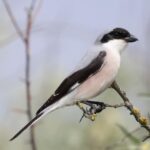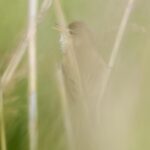Day 2 of a three day Winter & Brecks Tour, aiming to catch up with some of our wintering birds in North Norfolk, as well as the specialities of early spring in the Brecks. Saturday had been forecast to be the worst weather of the weekend but the forecast had seen a dramatic change during the day yesterday and was now forecast to be dry all day. We headed down to the Brecks to try our luck there today.
It was still drizzling when we met in North Norfolk, but dried up as we drove down and the sky started to brighten from the west. A couple of Red Kites circled over the road on the way, probably enjoying the improvement in the weather after the rain yesterday. As we got down to the Brecks and turned off the main road, we spotted a Barn Owl out hunting. It landed on a post and we pulled up nearby, at which point we noticed a second Barn Owl a few posts along.
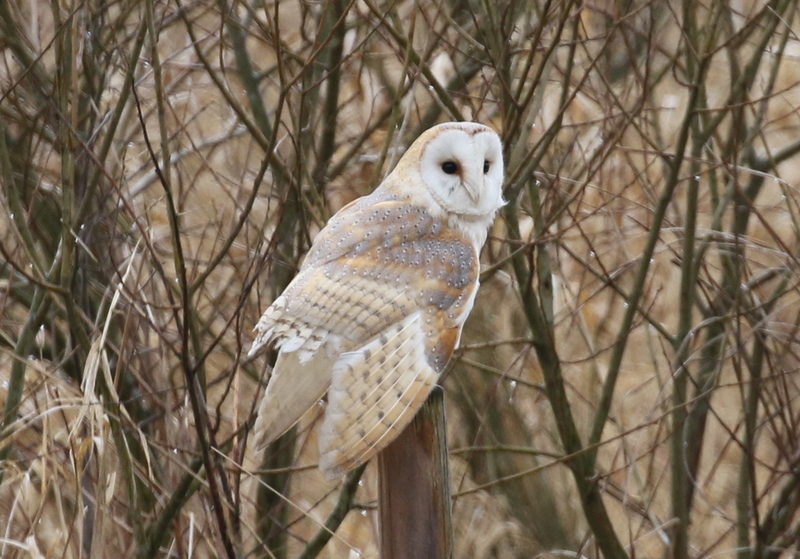 Barn Owl – one of a pair drying out this morning
Barn Owl – one of a pair drying out this morning
The Barn Owls seemed to be trying to dry themselves out, possibly after a wet night, perched on the posts with their wings held loosely. We watched them for a minute or so until they finally decided to resume hunting and flew off.
While we waited for the air to warm up, we went for a short walk into the forest first. We could hear a Goldcrest singing from the pines as we walked up a ride. When we came to a clearing, a Yellowhammer was singing from the top of a tall tree, where we could get it in the scope. A Common Buzzard flew across and landed on a telegraph post.
The forest itself was rather quiet – it was still rather cool, and damp from last night’s rain. There were a few Coal Tits and Blue Tits calling from the trees, as well as more Goldcrests. We heard a Marsh Tit too, from deep in the undergrowth, but it didn’t show itself. A steady succession of single Siskins flew over calling.
We could see some blue sky approaching, so we decided to head straight over to look for Goshawks. It was a wise move as, no sooner had we got on site, we were watching a juvenile Goshawk circle up out of the forest. Over the next hour and a half, we were treated to an amazing display of Goshawk activity. Rarely was there not at least one on view somewhere and there were at least five different birds present. At one point we had four Goshawks in the air at the same time!
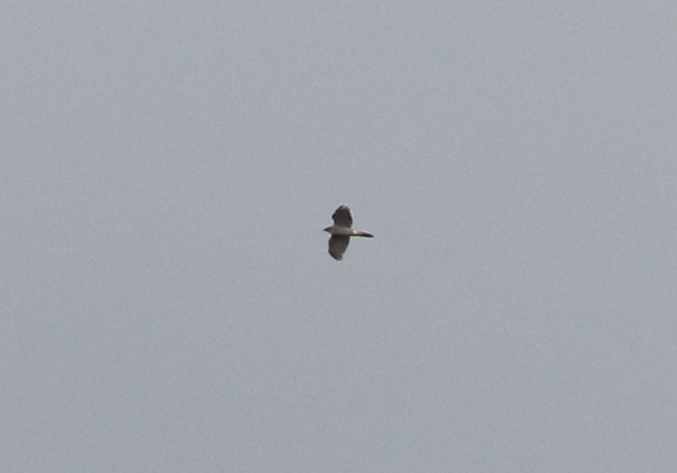 Goshawk – one of the adults, displaying
Goshawk – one of the adults, displaying
The juvenile Goshawks led the charge at first. After the first one appeared, we then had two juveniles up together. We could see their orange-tinged underparts and darker brownish upperparts as they circled. The juveniles started displaying and a pair, the larger female and smaller male, flew up and down together for a time. A third juvenile appeared, paler below than the other two.
Eventually, the adult Goshawks joined in the show. They responded mainly with slow flapping display, flying across over the trees with exaggerated wing beats. One circled up with its white undertail coverts fluffed out, known as ‘tail flagging’. Just as we were about to leave, one of the adults gave us a full rollercoaster display, swooping upwards steeply, closing its wings at the top and then stooping down sharply before turning back up, in a series of undulations, gradually losing height until it disappeared behind the trees. It was great to watch.
There were lots of Common Buzzards circling up too, of various shades, including a particularly pale white one. On several occasions, one of the Goshawks would drift over to join the Buzzards in their thermal, giving us a great size comparison. Goshawks are big and powerful birds, females are larger than males and a large female is not much smaller than a Buzzard. At one point, a Sparrowhawk circled up from the trees too and was dwarfed by the Buzzards.
Perhaps it was the weather which caused their to be so much activity today. Certainly it was good conditions for Goshawks to be displaying, a bit of blue sky between the clouds and a little warmth from the sun at times. But coming after a couple of damp days, perhaps they were also relieved at the opportunity to get up and show off!
There were birds other than raptors here too. The highlight was a Woodlark. We heard it singing first, and then looked over to see it hovering up over the edge of a field. It flew round and landed in the top of a tree, where we could get a view of it through the scope. A large flock of Fieldfares flew up from the fields behind us and landed in the trees, chacking away. A Mistle Thrush was singing from the treetops the other side.
Eventually we decided to tear ourselves away from the Goshawks and go off to explore another part of the forest. There had been a Great Grey Shrike here last weekend, but it had not been seen all week. It is possibly the same bird which was seen a couple of miles away two weeks previously, so it may be covering a large area. Still, we thought it might be worth a look and there are normally other things to see here too.
At first it seemed rather quiet as we set off along a track. It had clouded over and the temperature had dropped again. There was no sign of the shrike where it had been seen before. However, we could hear Woodlarks and Redpolls calling, so we set off to look for them. We saw one of the Woodlarks drop down from the trees across the other side of a clearing, so we set off round towards it. When we got there, it was hiding in a rut at first, but then it flew up followed by a second Woodlark, as we approached. They landed further over.
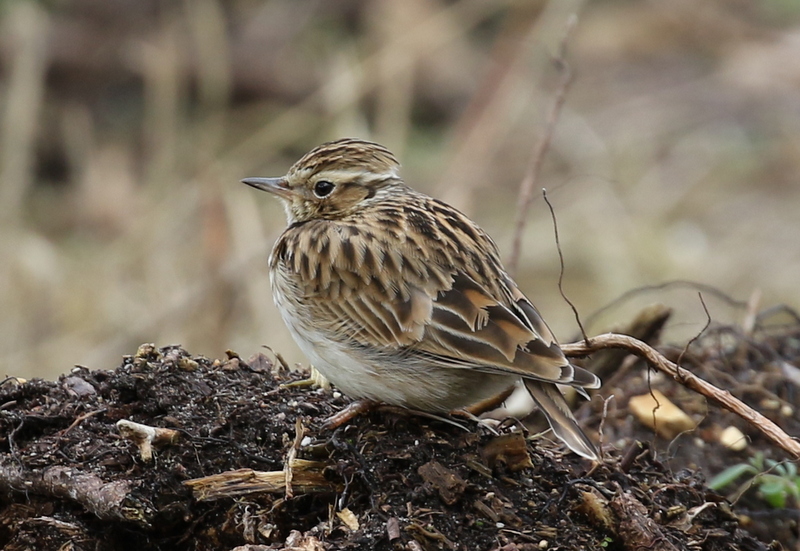 Woodlark – one of the birds in the same clearing taken a few days ago
Woodlark – one of the birds in the same clearing taken a few days ago
While we were chasing after the Woodlark, we had forgotten about the Redpolls, but the next thing we knew they were feeding in the trees right beside us.There were four at first. Looking at them now we could see they were Lesser Redpolls, quite rich brown toned birds with brown rumps. A nice bright male had a lovely pinky red wash over its breast, as well as the red ‘poll’ on its forehead. As we watched them feeding on the buds of the bare tree, we realised there were more in a thicker clump of trees a little further along and, when they eventually all flew off, there were at least fifteen of them here.
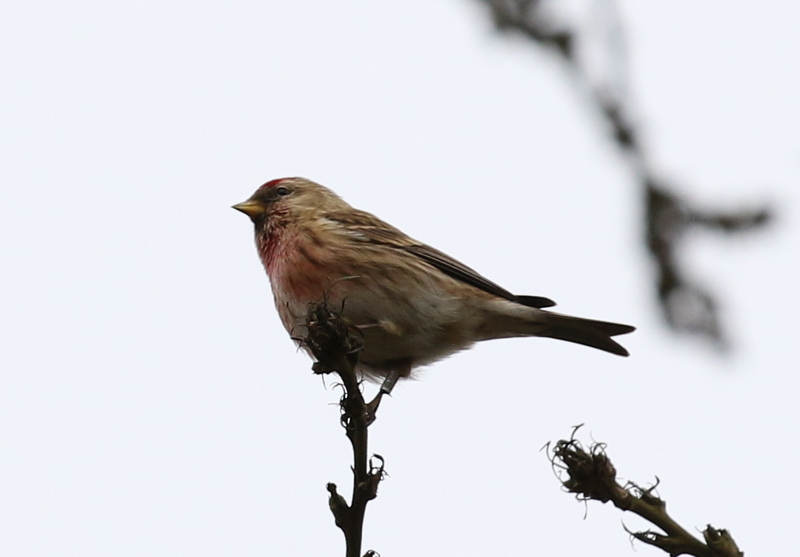 Lesser Redpoll – a male with pinky-red washed breast
Lesser Redpoll – a male with pinky-red washed breast
The Woodlarks proved hard to see on the ground at first, but after we had finished watching the Redpolls, the male Woodlark flew across and landed on a tussock, where we could get a good look at it in the scope. As we walked back across the clearing, it flew up in front of us and gave us a nice burst of song as it fluttered overhead.
When we got back to the car, there were a couple of Treecreepers in the trees by the road. A Marsh Tit was feeding nearby and a Nuthatch was calling from a large oak tree. It was already lunchtime, so we drove round to Santon Downham for a break and something to eat. While we were there, we could hear a Marsh Tit singing from the trees.
After lunch, we drove round to Lynford Arboretum. As we walked in along the track, we could see a small cluster of photographers at the gate by the feeders. Apparently there had been a Hawfinch here earlier, right at the back, but it was not on view. However, there were several nice Bramblings down in the leaf litter, males with bright orange shoulders and breasts and varying shades of head between grey and black, plus browner females.
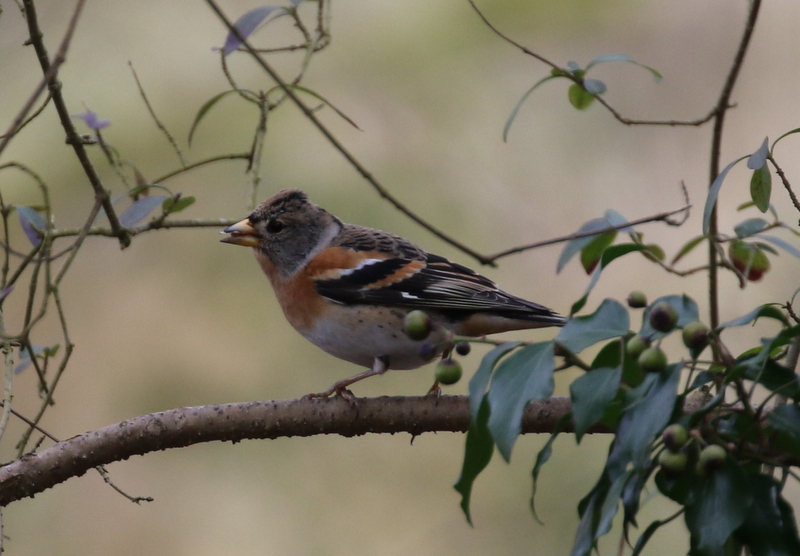 Brambling – a male, with its summer black head just beginning to appear
Brambling – a male, with its summer black head just beginning to appear
We could hear Hawfinch calling, a quiet ‘tic-tic’, from the trees, so we walked along to look the other side. There was no sign of it at first, but after a short while it appeared out in the grass on the edge of the trees. We were just watching it through the scope when it was flushed by a child riding round on a quad bike – he seemed to like riding round in front of all the birders and flushing the birds! The Hawfinch flew back into the trees, where we could hear it still calling.
Thankfully, the Hawfinch came out again after a few minutes and landed back on the grass the other side of the clearing. It was a smart male, rich chestnut brown around the head, with a contrasting grey collar. We had a great look at it through the scope as it hopped around on the ground. It seemed to be looking for sycamore keys – it kept picking up bits in its bill and when it found a key with a seed, would chomp on it with its huge bill until it got to the seed. The Hawfinch was accompanied by two Bramblings, which looked tiny by comparison, and a Song Thrush.
 Hawfinch – this male was looking in the grass for sycamore keys
Hawfinch – this male was looking in the grass for sycamore keys
Here’s some video of the Hawfinch on the grass from a couple of days ago:
When the Hawfinch was flushed again, it flew up into the trees above the feeders. We walked back to the gate and, after a couple of minutes, could hear it calling from the holly trees a bit further along. When we walked over to see if we could see it, we could hear that it was singing. Hawfinch song itself is nothing much to write home about, a quiet jumble of sharp and grating calls, but it is still great to hear. We couldn’t see it and after a while it flew back to the tree tunnel, where it perched out of view in the trees calling, before flying off over the arboretum.
Even though the male had flown off, we could still hear a Hawfinch calling from the trees the other side of the chicken pen. We walked up that way and it appeared right in the tops. It was a female, much duller grey brown compared to the male. Still, we got it in the scope and had a great look at it. Eventually, as a crowd started to gather below it, it flew back into the trees.
 Hawfinch – a duller female in the trees
Hawfinch – a duller female in the trees
It was that time of the day when the Hawfinches start to gather to roost, so we made our way down towards the paddocks. There was lots of bird seed put out on the pillars of the bridge, and loads of birds coming down to feed on it. However, as we walked up to the bridge we could hear Crossbills calling from high in the poplars. We hurried on down the path the other side, just in time to see five Crossbills fly off south over the meadow beyond.
Back at the bridge, we spent some time watching the comings and goings at the bird seed. There was a succession of tits flying in, grabbing a beak-full, and darting back to the safety of the trees. As well as the usual Blue Tits, Great Tits and Long-tailed Tits, we had great views of Coal Tit and Marsh Tit. The latter in particular are always good to see up close.
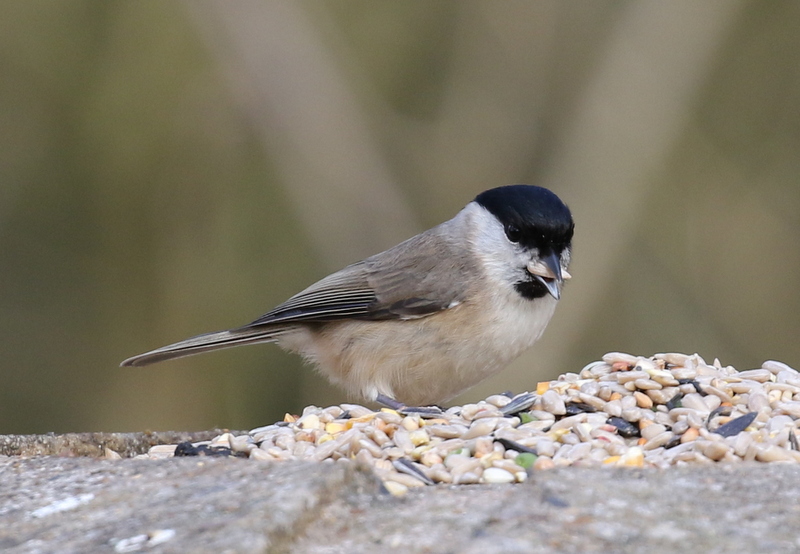 Marsh Tit – feeding on the seed at the bridge
Marsh Tit – feeding on the seed at the bridge
A couple of Nuthatches kept coming down to the seed too, as did a Reed Bunting and several Chaffinches. Lots of Siskins were feeding in the trees above and several came down to a muddy pool to drink. It was a hive of activity here.
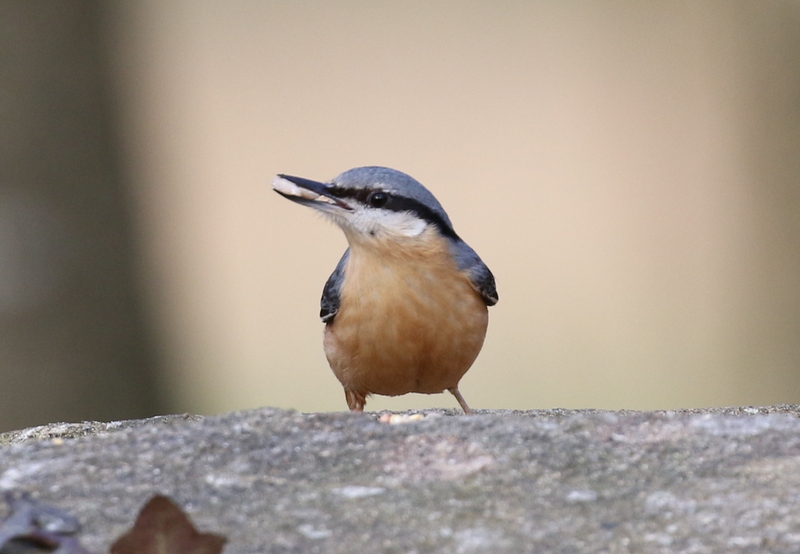 Nuthatch – also coming to the seed at the bridge
Nuthatch – also coming to the seed at the bridge
We heard more Crossbills calling as they flew in. One landed in the alders briefly, before all three flew up into the tops of the poplars. We hurried down the path again, just in time to see them, two red males and a green/yellow female, chasing around in the branches before dropping down through the trees, presumably to drink.
While we waited for the Crossbills hopefully to reappear, we turned our attention to the paddocks. Scanning the tops of the trees beyond, we picked up a Hawfinch high in the top of a fir tree. A second Hawfinch was in another tree nearby. Then the first flew down towards the trees in the middle of the paddocks, where it landed. We walked further along the path, still with one eye back on the poplars, but the Hawfinch had dropped down towards the ground out of view.
It seemed like the Crossbills we had seen in the poplars were not going to come back up into the tops, but standing by the paddocks we heard more Crossbills calling from the pines nearby. We walked along to look for them and there was no sign of any movement in the trees initially, until we heard a cone dropping through one of the trees. That is a sure giveaway, the birds dropping the cones when they are finished extracting the seeds from them, and we quickly honed in on where they were.
To our surprise, the first Crossbill we set eyes on was a streaky juvenile. This is the first juvenile we have seen this year. Crossbills will breed in almost any month of the year, and will often have their first nesting attempt in January or even December. As we looked more closely at the tree, we could see there were actually two juveniles and two bright red males.
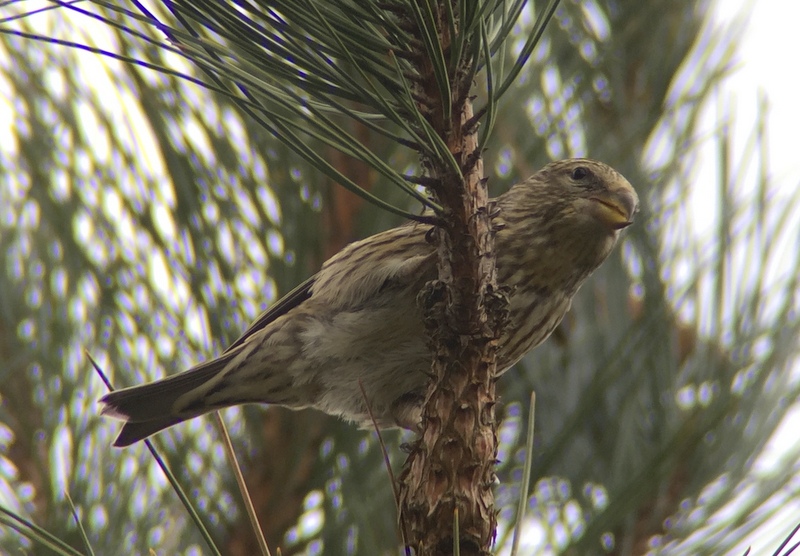 Crossbill – a streaky juvenile
Crossbill – a streaky juvenile
The juvenile Crossbills were clambering around, picking at the cones and even pulling at the bark on the branches, still not able to feed themselves. The males were busy feeding, extracting seed from the cones. At one point, we watched as one of the males hopped over and fed one of the begging youngsters – regurgitating half digested seed for it. It was fascinating to watch.
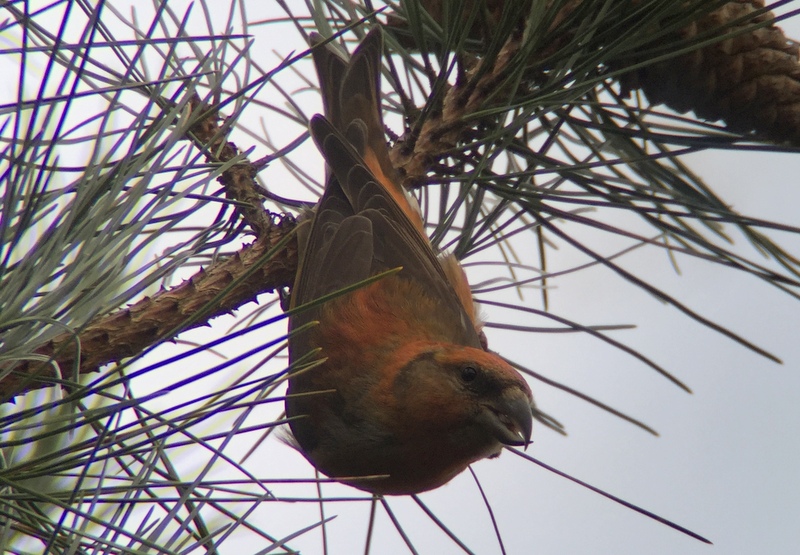 Crossbill – a red male hanging on a cone, check out the distinctive crossed mandibles
Crossbill – a red male hanging on a cone, check out the distinctive crossed mandibles
We thought there might be a female nearby, but when they flew off there were just the four Crossbills together. As we walked back towards the bridge, we could hear Crossbills calling from the poplars and there were the two juveniles with one of the adult males. That might mean the female Crossbill is incubating a second clutch somewhere nearby, and the male has been left to care for the first brood until they are able to fend for themselves.
While we were watching the Crossbills, we heard several Hawfinches flying over towards the paddocks. We turned back to look over in that direction and could see a few Hawfinches in the tops of the trees beyond. At first, we could just see two or three in the very tops of a couple of pines, but on closer inspection we found more, with nine together in a lower deciduous tree. There were at least fifteen in total.
The number of Hawfinch here have dropped in recent weeks, from their peak at the start of the year, which may indicate that migrants which had spent the winter here, with our resident Hawfinches, have already left on their way back. Still, fifteen is a very respectable number – there aren’t many places in the UK where you can see a flock of that size these days. While we were watching them, we heard Mandarin calling and turned to see a pair flying away from us over the lake.
After a really great day in the Brecks, it was time to head for home now. As we drove back to North Norfolk,we drove through the area where we had looked for the Pallid Harrier yesterday. It had been showing all day today, since about 10am, but by the time we got back it was a bit too late in the day, and the sun was going down. We had a quick look for it, but it turned out that it had flown off about an hour earlier. Typical!
We did spot a Red Kite high in a tree right above the road, feeding on something. A Barn Owl flew across the road in front of us and along the verge, before flipping over the hedge. It was a perfect book end to the day – Red Kites and Barn Owls to start and finish.
